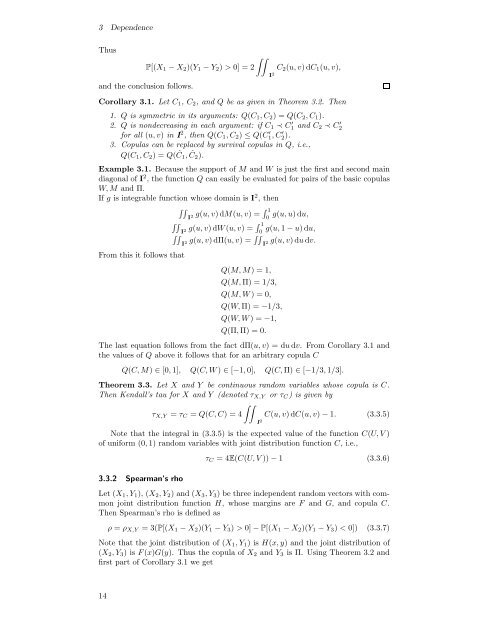Modelling Dependence with Copulas - IFOR
Modelling Dependence with Copulas - IFOR
Modelling Dependence with Copulas - IFOR
Create successful ePaper yourself
Turn your PDF publications into a flip-book with our unique Google optimized e-Paper software.
3 <strong>Dependence</strong><br />
Thus<br />
∫∫<br />
P[(X 1 − X 2 )(Y 1 − Y 2 ) > 0] = 2 C 2 (u, v)dC 1 (u, v),<br />
I 2<br />
and the conclusion follows.<br />
Corollary 3.1. Let C 1 , C 2 ,andQ be as given in Theorem 3.2. Then<br />
1. Q is symmetric in its arguments: Q(C 1 ,C 2 )=Q(C 2 ,C 1 ).<br />
2. Q is nondecreasing in each argument: if C 1 ≺ C 1 ′ and C 2 ≺ C 2<br />
′<br />
for all (u, v) in I 2 ,thenQ(C 1 ,C 2 ) ≤ Q(C 1,C ′ 2).<br />
′<br />
3. <strong>Copulas</strong> can be replaced by survival copulas in Q, i.e.,<br />
Q(C 1 ,C 2 )=Q(Ĉ1, Ĉ2).<br />
Example 3.1. Because the support of M and W is just the first and second main<br />
diagonal of I 2 , the function Q can easily be evaluated for pairs of the basic copulas<br />
W, M and Π.<br />
If g is integrable function whose domain is I 2 ,then<br />
∫∫<br />
g(u, v)dM(u, v) = ∫ 1<br />
g(u, u)du,<br />
I 2 0<br />
∫∫<br />
I<br />
g(u, v)dW (u, v) = ∫ 1<br />
2 0<br />
g(u, 1 − u)du,<br />
∫∫<br />
g(u, v)dΠ(u, v) = ∫∫ g(u, v)du dv.<br />
I 2 I 2<br />
From this it follows that<br />
Q(M,M)=1,<br />
Q(M,Π) = 1/3,<br />
Q(M,W) =0,<br />
Q(W, Π) = −1/3,<br />
Q(W, W )=−1,<br />
Q(Π, Π) = 0.<br />
The last equation follows from the fact dΠ(u, v) =du dv. From Corollary 3.1 and<br />
the values of Q above it follows that for an arbitrary copula C<br />
Q(C, M) ∈ [0, 1], Q(C, W ) ∈ [−1, 0], Q(C, Π) ∈ [−1/3, 1/3].<br />
Theorem 3.3. Let X and Y be continuous random variables whose copula is C.<br />
Then Kendall’s tau for X and Y (denoted τ X,Y or τ C ) is given by<br />
∫∫<br />
τ X,Y = τ C = Q(C, C) =4 C(u, v)dC(u, v) − 1. (3.3.5)<br />
I 2<br />
Note that the integral in (3.3.5) is the expected value of the function C(U, V )<br />
of uniform (0, 1) random variables <strong>with</strong> joint distribution function C, i.e.,<br />
3.3.2 Spearman’s rho<br />
τ C =4E(C(U, V )) − 1 (3.3.6)<br />
Let (X 1 ,Y 1 ), (X 2 ,Y 2 )and(X 3 ,Y 3 ) be three independent random vectors <strong>with</strong> common<br />
joint distribution function H, whose margins are F and G, and copula C.<br />
Then Spearman’s rho is defined as<br />
ρ = ρ X,Y =3(P[(X 1 − X 2 )(Y 1 − Y 3 ) > 0] − P[(X 1 − X 2 )(Y 1 − Y 3 ) < 0]) (3.3.7)<br />
Note that the joint distribution of (X 1 ,Y 1 )isH(x, y) and the joint distribution of<br />
(X 2 ,Y 3 )isF (x)G(y). Thus the copula of X 2 and Y 3 is Π. Using Theorem 3.2 and<br />
first part of Corollary 3.1 we get<br />
14
















